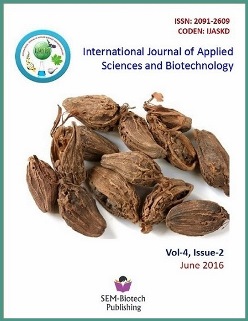Assessing the Economic and Energy Use Efficiencies of Direct Seeded and Transplanted Rice (Oryza sativa L.) in Lamjung, Nepal
DOI:
https://doi.org/10.3126/ijasbt.v4i2.14854Keywords:
DSR, Economic use efficiency, Energy use efficiency, Partial-factor productivity, TPRAbstract
To meet the basic food needs of expanding human population a productive sustainable agricultural system must become a major priority in Nepal. An on-farm study was conducted to investigate the economic and energy use efficiencies of rice (Oryza sativa L.) under direct seeded (DSR) and transplanted (TPR) conditions at Lamjung campus. Five varieties of rice differing in phenology and growth (viz. US382, Sukha dhan, NR10676, NR10490 and Khumal10) were tested in Randomized Complete Block Design under DSR and TPR conditions with three replications. The statistical resulted revealed that the average grain yield was highest for TPR-NR10490 (7.52t ha-1), whereas the lowest in DSR- NR10676 (1.96t ha-1). The output energy obtained from grain and biomass yield was highest under TPR-NR10490 (2.05x105MJ ha-1) followed by the lowest in DSR-NR10676 (7.35x104MJ ha-1). In TPR-NR10490 the most energy use efficiency (output-input ratio of 9.22) was obtained whereas in TPR-Sukha dhan, energy use efficiency (output-input ratio of 1.01) was least. Partial-factor productivity and nutrient uptake was highest in TPR-NR10490 and the lowest in DSR- NR10676. The maximum productivity and profitability was recorded in TPR-NR10490 while reverse in DSR-Sukha dhan. The benefit cost ratio was found highest in TPR- NR10490 (4.45) and lowest in DSR-Sukha dhan (2.31). From above result, NR10490 was found to be the best variety under transplanted condition.
Int J Appl Sci Biotechnol, Vol 4(2): 172-177




